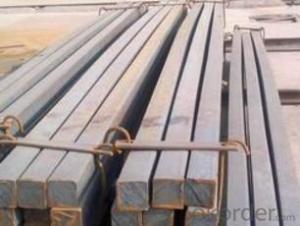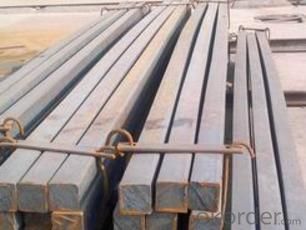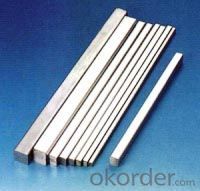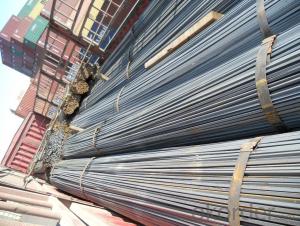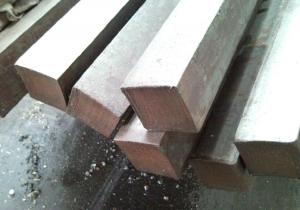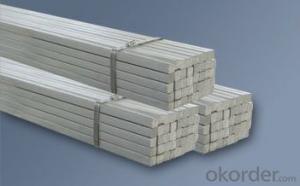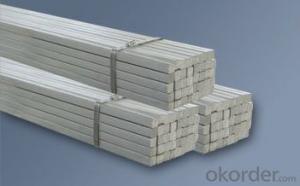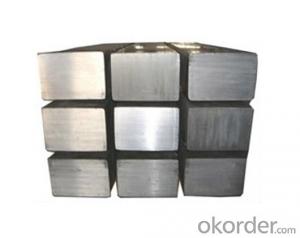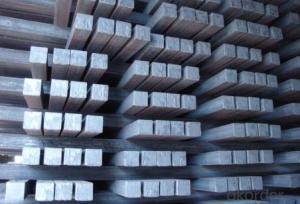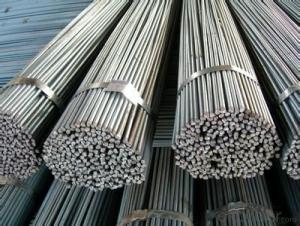Q275Cr High Quality Steel Square Bar
- Loading Port:
- Tianjin
- Payment Terms:
- TT OR LC
- Min Order Qty:
- 1000 m.t.
- Supply Capability:
- 100000 m.t./month
OKorder Service Pledge
OKorder Financial Service
You Might Also Like
Product Description:
Product Description:
In the production of steel products, steel is molded and reshaped with different machinery at different temperatures. One process is steel rolling, which involves metal stock passing through a pair of rolls. Rolling produces flat steel sheets of a specific thickness, and the process is classified according to the temperature at which the metal is rolled. If the temperature of the metal is above its recrystallization temperature, or the temperature at which the grain structure of the metal can be altered, then the process is termed as hot rolling. If the temperature of the metal is below its recrystallization temperature, the process is termed as cold rolling.
Like cold rolling, cold drawing is performed at room temperature, but instead of producing a flat object like a coke can, cold drawing makes steel into the form of a wire like the spokes of a wheel or a paper clip. To start the process, Steel is usual hammered and rolled so that it can be fit through a die; a tool that turns the steel mass into a wire. The room temperature steel is pulled through the die which reshapes it into a thinner shape while maintaining the same volume. It is similar to the idea of syrup flowing out of a bottle through a tube in that it changes shape but not volume, but instead of squeezing the metal, it is pulled out. In order to get the wire down to the right diameter, it usually requires more than one pass through different dies.
Colddrawn steel, steel covered carbon steel, excellent carbon steel, alloy structural steel, carbon tool steel, spring steel, bearing steel, tool steel, cold heading steel, free cutting steel, martensite stainless steel; products include all kinds of shapes round, square steel, hexagonal, flat steel and other conventional products, including various special-shaped steel products. In all types of colddrawn steel industry has been widely used, these areas include automotive, machine tools, furniture, standard parts, textile machinery, agricultural machinery, military industry and other industries.
The total assets of more than 40 million, as of the end of 2010 with fixed assets of 34 million, with 60 tons from 5 tons a chain drawing machine 10 sets, horizontal and inverted coiled wire drawing machine 5 sets, steel and plate production line of blasting, high-power ham stove, various straightening machine and cold rolling mill and other major equipment.
Usage/Applications
-The Square Bar is normally used as structure steel.
-Row material for other structure steel like steel angles, channels, I-beams, H-beams, etc…
Packaging & Delivery
-Packing Detail: The products can be packed in bundles by steel wires.
-Marks: We make tag marks and color marks. The tag marks with white background and red company logo will be tied up to each bundle of the products. The information is usually including basic information of products and company and other information requested by customers. As for color marks, we will paint both ends of bundles to make sure that it w
-Delivery Detail: 30~45 working days after receive buyer’s T.T. or L/C.
ill be more convenient for customers to distinguish them from other products.
- Q: Can a steel square be used for checking the squareness of door frames?
- Yes, a steel square can be used for checking the squareness of door frames.
- Q: Can a steel square be used for automotive repairs?
- Yes, a steel square can be used for automotive repairs. A steel square, also known as a framing square or carpenter's square, is a versatile tool that can be used in a variety of applications, including automotive repairs. It can be used to check and mark straight edges, ensure proper angles, measure distances, and create precise cuts. In automotive repairs, a steel square can be particularly useful for measuring and aligning components, checking for squareness, and verifying the accuracy of angles during the repair process. Whether it's for bodywork, frame straightening, or other automotive repairs, a steel square can provide a reliable and accurate reference tool, making it a valuable asset in any automotive repair toolkit.
- Q: How do you use a steel square for marking and cutting finger joints?
- To use a steel square for marking and cutting finger joints, first, align the square's blade against the edge of the wood board. Then, mark the desired depth and width of the finger joint on the wood using the square's measurements and lines. Next, use a saw to cut along the marked lines while ensuring the square remains steady against the wood. Finally, repeat the process on the adjoining piece of wood to create the matching finger joint, ensuring the measurements align for a precise fit.
- Q: How do you use a steel square to check for levelness on a shelf?
- To use a steel square to check for levelness on a shelf, place the steel square against the edge of the shelf and ensure it is flush with the surface. Then, use a spirit level to check if the bubble is centered within the level. If it is, the shelf is level. If not, adjustments can be made based on the reading to achieve a level surface.
- Q: How do you use a steel square for marking roof dormer angles?
- In order to mark roof dormer angles, one must follow a series of steps. To begin, position the steel square on the roof's edge where the dormer will be placed. Ensure that the square is aligned with the roof's pitch or slope by placing the longer arm of the square against the roof. Next, align the square's shorter arm with the desired angle for the dormer, which will depend on the specific design and specifications of the dormer being constructed. Once the square is correctly aligned, use a pencil or marker to trace along the shorter arm's edge. This will create a straight line on the roof, indicating the angle at which the dormer will be built. Repeat this process for each side of the dormer, making sure to maintain consistency in the angles and measurements. After marking all the necessary angles, these lines can be used as guides for cutting and constructing the dormer. Prior to proceeding with the construction process, it is important to double-check the measurements and angles. By utilizing a steel square for marking roof dormer angles, one can achieve precise and accurate measurements, resulting in a dormer that seamlessly integrates with the existing roof structure. It is vital to adhere to safety guidelines and utilize appropriate tools when working on any roofing project.
- Q: How do you use a steel square to measure diagonals?
- To use a steel square to measure diagonals, simply place the square against the corner of the object or surface you want to measure. Align one edge of the square with one side of the object and make sure the other edge is perpendicular to it. Then, measure the diagonal by extending the other edge of the square until it reaches the opposite corner. The measurement you obtain is the length of the diagonal.
- Q: Can a steel square be used for checking the squareness of a table saw rip fence?
- Yes, a steel square can be used to check the squareness of a table saw rip fence.
- Q: How do you determine the squareness of a steel square?
- To determine the squareness of a steel square, you can use a reliable reference square or a precision measurement tool like a squareness gauge. Place the steel square against a straight edge and check if the perpendicular edges align perfectly with the reference square or gauge. If there is any deviation or gap between the edges, it indicates a lack of squareness.
- Q: Can a steel square be used for layout and design work?
- Indeed, layout and design work can make use of a steel square. Steel squares, which are alternatively referred to as framing squares or carpenter squares, are versatile instruments frequently employed by carpenters, woodworkers, and other skilled professionals for tasks involving layout, design, and measurement. They consist of an elongated arm and a shorter arm set at a right angle. Typically, the elongated arm is marked with measurements and angles, facilitating the accurate layout of lines, angles, and squares. The shorter arm proves valuable in examining corners and ensuring perpendicularity. Steel squares possess durability and reliability, making them excellent choices for a multitude of layout and design assignments, such as marking cuts, inspecting angles, and creating precise measurements.
- Q: Can a steel square be used for checking the plumbness of a corner post?
- No, a steel square cannot be used for checking the plumbness of a corner post. A steel square is primarily designed for measuring and marking right angles, not for determining vertical alignment. For checking plumbness, a level or plumb bob would be more suitable tools.
Send your message to us
Q275Cr High Quality Steel Square Bar
- Loading Port:
- Tianjin
- Payment Terms:
- TT OR LC
- Min Order Qty:
- 1000 m.t.
- Supply Capability:
- 100000 m.t./month
OKorder Service Pledge
OKorder Financial Service
Similar products
Hot products
Hot Searches
Related keywords
